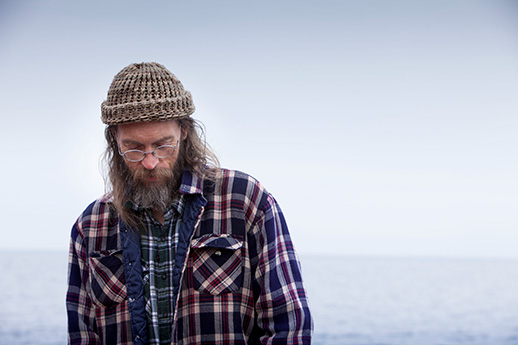Meeting Charlie Parr – Teaser II from meetingcharlieparr on Vimeo.
Caught by the River Poet-in-Residence, Will Burns, reviews a new documentary film on the life of the folksinger Charlie Parr:
It was my brother who first introduced me to the music of Charlie Parr. We used to hang out at each other’s houses, play guitars, drink litronas of San Miguel and listen to music. All very standard stuff, of course. Then one night he put on a song called Who Killed Cock Robin and told us to shut up and listen, Dave Van Ronk-style. I fell for the guitar playing right away and then the heavy mix of fable and folk song all shot through with an audible DIY sensibility.
It is testament to Francois-Xavier Dubois, Charles Dubois, Julien Bertrand, and Nicolas Reverchon’s beautifully crafted film about Charlie Parr that they perfectly capture the deft balancing act that makes his music the great art that it undoubtedly is. The film opens with a series of wonderfully shot images of modern North-Eastern city life before bringing in interview footage with the music writer Wayne Robins which begins by pulling out the academic aspects of the folk process that a songwriter and indeed songfinder like Parr is engaged with, before moving through conversations with promoters, collaborators and friends and family to shift focus from the critical-intellectual to the work itself, and then slowly into the domestic and geographical. It is expertly paced.
While old folk songs, gospel tunes and traditional ballads make up part of the artistic dialogue that many artists are involved in, there is something more intrinsic somehow about these ideas with Charlie Parr. Perhaps his integrity and knowledge synthesize these ideas in such a way as to make them vital, living facets of his work, barely distinguishable from his own original songs. And yet, he remains distinct in his voice, able to skillfully transmute elements from the well of American (and precursory) folk idioms into his own art. The film draws this out in two ways—there are long, cinematic tracts, beautifully shot and haunted by intricate instrumental guitar pieces, or at times extended intros, that show Parr and his geographical environment, the edges of Minnesotan urbanity giving way to Great Lake coastlines, damaged-looking suburbia and the vast, mythic American forest. The photography here is exquisite, and distills the inter-play between that kind of quiet urbanity and the expansive, primitive sublime that is almost exclusively American. We see the dying remnants of factory towns, train lines out of the city, tiny clubs, sandwich shops and dingy bars before we are given shots of the long, lonely roads and bright red and yellow fall foliage of the natural world just beyond. This juxtaposition is a wonderfully crafted metaphor for the kind of folk process that Parr’s art exemplifies; it relies on clubs, bars, people, and yet it is somehow rooted in an older, more rural existence.
And this is the second thread that the filmmakers themselves pull on. By slowly bringing out elements in both the human-geographical history of Parr’s native Austin, Minnesota and the nature of his own day-to-day existence as a musician, the film reveals the humanity of his work, while reinforcing its correlation with Parr’s environment. Through his relationship with fellow musicians, his insistence on recording in garages or churches or communal spaces rather than expensive studios, driving himself to shows, singing on his porch with his wife, we are brought to an understanding of art-as-way-of-life, as an extension of a working-class sensibility. And this is not the working class as mythologized by Springsteen, this is the real thing, someone working day in, day out. A craftsman.
The use of human geography is subtle, Parr himself describing childhood memories of the strikes at his father’s factory, the scabs in the local bars, but is hugely effective. It acts as a kind of seal on the aesthetic whole we are presented in the film and also opens up perhaps the most vivid element of the whole film—the interviews with Charlie Parr himself. He is a hugely intelligent, erudite and thoughtful man and his means of expressing himself and his world and artistic view are engaging and original. Again the filmmakers deserve credit for extracting some real juice here.
Overall, what comes out of this film is an enormous sense of what art means in a real life. This is art at the opposite end of a spectrum where Damien Hirst sells diamond encrusted skulls for millions of pounds, where Soho dandies quote Oscar Wilde in their members’ clubs or where urbane novelists row about semantics in the letters’ pages of the London Review of Books. This film quite brilliantly builds a picture of the depth of simplicity—a group of friends, a marriage, living and working and out of all that the creation of beautiful, deep, rich works that resonate with honesty and intelligence. As does the film itself.
